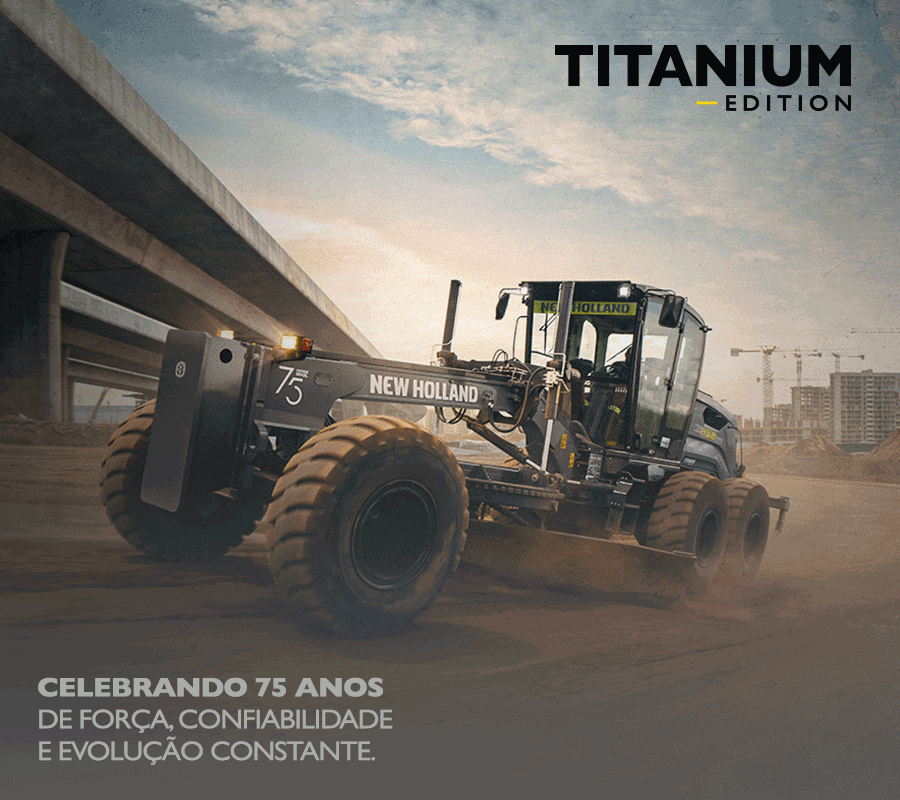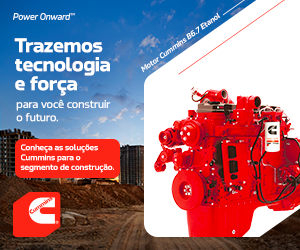Small but admirable
With annual growth rates above those of large, heavy-construction equipment (in Brazil a.k.a. the ‘yellow’ equipment line), mini-machines gain space in applications in a wide variety of segments of construction, mining and agriculture

With the market booming, the sky’s the limit for equipment such as skid steers and mini excavators in Brazil. Amid the optimism, there isn’t even a trace of a consensus as to how great the potential for growth is in the medium term. Forecasts as to average expected growth rates vary depending on who you’re talking to, and range anywhere from 5% to 30% for a particular type of equipment.
The wide range of possibilities was sketched by several manufacturers who were interviewed by M&T magazine for this report, demonstrating the promising scenario for compact equipment is only beginning to take shape in Brazil. But despite its incipience, this is a niche that is already displaying its muscular build: from 2007 to 2012, the total number of compact machines sold in the country increased almost fivefold, growing from 700 units per year to approximately 3,400.
Last year, the Sobratema Study of the Brazilian Market for Construction Equipment had already validated this evolution. The survey showed that while sales of heavy ‘yellow line’ construction equipment (e.g. earth movers, motor graders, excavators, etc.) shrank 3%, skid steers advanced 5%, climbing from 3,300 to 3,400 units compared to 2011. Sales of mini excavators grew 19%, rising from 800 to 900 units in the same period.
Strategies
This is the market of which the manufacturers we interviewed, and a significant number of other competitors with operations in Brazil, want a lion’s share. Of course, even though they may have the same goal in mind, the strategies to get there are different. Before we examine what they are, it is worth noting that absolutely all of the compact machines sold in Brazil have been imported since 2011, when Volvo CE - until then the only brand that manufactured such machines in the country - decided to concentrate the production of these machines at its plants in Europe and the United States.
“Today, we offer seven models of skid steers to Brazil, with load capacities between 600 and 1200 kg,” says Jacó Alles, regional sales manager for Latin America at Volvo CE. As regards mini excavators, the company has four models, the smallest of which has an operating weight of 2.7 tons and the largest 8.8 tons.
According to Juliano Silva, sales engineer for the Latin-American market at Volvo CE, the Swedish manufacturer’s mini excavators come equipped with metal or rubber tracks, when they do not come with wheels and rubber tires. “The choice will depend on the condition of the soil at the work site, such as when the need to exert low pressure on the ground with mud, for example, demands the use of metal tracks to ensure better distribution of the equipment’s weight per area and promote increased traction,” explains the executive. “Now, in more delicate and sensitive soils, such as the soil in gardens or in the interior of buildings, rubber tracks are more suitable, and rubber tires remain, preferably, to be applied in operations that require greater speed in the movement of equipment.
Within the same operating range presented by Volvo CE, JCB placed its first bets on compact equipment for the domestic market. The brand’s skid steer loaders with a load capacity of 703 kg are produced in the United States and became available in Brazil last year when they were introduced during M&T Expo 2012. Among their distinctions, these machines feature a panoramic cab which - according to the manufacturer - provides visibility up to 60% greater than similar equipment. “We plan to ad another skid steer loader model, in the range of 1.5 t load capacity, which should be announced as of 2014,” says Nei Hamilton, commercial director of JCB in Brazil.
Until this new model arrives, the first JCB mini excavator for Brazil began selling in January of this year. It is a machine with operating weight of 2.8 t and which, according to Hamilton, meets the market’s mains needs. “This equipment has a knuckle boom to enable lateral rotation,” said the director, explaining that it allows the machine to dig toward its tracks since it rotates laterally at angles of up to 60 degrees to the left and 45 degrees to the right. “In operation, this allows you to dig material in more positions without having to move the machine, which provides greater productivity at the work site,” he says.
Replacement
To Nicola D’Arpino, marketing manager at New Holland, Brazil is beginning to witness what is already commonplace in Europe: the replacement of backhoes with skid steer loaders or mini excavators in various services. According to him, this represents a gain in competitiveness, especially for equipment rental companies and subcontractors who incorporate two machines into their fleets instead of just one. “The manager may assign the excavator to one job and the skid steer loader to another,” exemplifies D’Arpino. “Thus, critical mass is gained without increasing the total investment since the amount that would be spent for the purchase of a backhoe is similar to what you invest in two compact machines.”
Jacó Alles, of Volvo CE, recalls how common it had become to find backhoes performing services that would be more productive if mini equipment were applied. “What I’m referring to is excavations in urban centers, where the small size of compact equipment offers numerous advantages over backhoes,” he explains. “I also point out services such as the placement and positioning of pipes, digging of small ditches, basic sanitation works and others.”
In one of the simulations conducted by Alles and his team, an urban excavation performed with a skid steer loader equipped with a digging implement was compared to the same job done with the use of a backhoe. He reports that while the truck to transport excavated material is positioned beside the backhoe for loading (a process that occupies two lanes of the street, with a skid steer loader the truck remains either ahead of or behind the machine, occupying only one lane. “That's because the skid steer loader is capable of digging, doing a 180 degree turn, and dumping the excavated soil onto the bed of the truck in a smaller maneuvering space,” he explains. “This, of course, is very important on an urban street or road with heavy traffic.”
Pioneer
In the assessment of Alberto Rivera, commercial manager of Doosan - the owner of the Bobcat brand, the market has already evolved significantly in relation to the use of compact equipment. “That’s precisely why we should bet on it,” says the executive, who represents a company the pioneered sales of such equipment in Brazil. “Proof of how promising this market is is the amazing growth in the offer of these machines by manufacturers with a national presence,” he says. “And that is even stronger with regard to mini excavators where the number of competitors is greater.
Bobcat brand skid steer loaders, according to Rivera, are available in load capacities ranging from 318 kg to 1.8 tons. “There are 13 models in all, covering all the needs of the market, though the highest demand is focused on machines in the 900 kg capacity range,” he informs.
He points out that the main developments in the brand’s skid steers have been in the placement of implements, which are now better protected within the loader arms. “Furthermore, our machines come with a choice of three control options: lever, joystick or with a combination of both types of controls,” he says, explaining that the choice is made based on the application that the machine will be used for, since the joystick is ideal for services that require a sequence of speed, such as asphalt milling. “With a lever, the operator can get tired during the operation and vary the ground speed of the machine, thus compromising the regularity of the pavement,” he says, underscoring the possibility of programming speeds with the use of a joystick.
According to Rivera, the levers are preferred by operators, especially in works of ‘attack’ for digging or loading. “Levers give equipment operators the feeling of an extension of their own arms, making the force that is exerted during loading or excavating more perceptible,” explains the expert. Furthermore, a machine with a joystick is 5% to 8% more expensive, he says. In the segment of mini excavators, Bobcat offers 10 models with operating weights between 1 ton and 8 tons. “The preference is for machines ranging from 2 to 3 tons, but we have already noticed a trend for larger machines, in the range of 5 tons of operating weight,” says the brand's commercial manager.
Potential
It is precisely in that range that Sany has bet to increase its line of compact machines in Brazil. The Chinese manufacturer offers mini excavators of 5 and 7 tons for which there is strong demand in the rental market. “In 2012, approximately 85% of the Sany mini excavators were sold to rental companies that operate mainly with civil construction contractors, urban construction and sanitation in the South and Southeast Regions of the country,” says Marcelo Jutwak, manager of the heavy equipment line at Sany Brazil.
According to him, these machines have demonstrated their sales strength among all the company’s competitors, since in 2012 mini excavators accounted for some 15% of the units of all sizes sold in the country. “At Sany, the proportion is even more significant since 23% of the units of excavators that we sold last year were in the compact class,” says Jutwak. Since they are less expensive to acquire, mini excavators have a lower average ticket price and, therefore, contributed with 9% of the company’s revenue from sales of Sany excavators last year, the manager adds.

Av. Francisco Matarazzo, 404 Cj. 701/703 Água Branca - CEP 05001-000 São Paulo/SP
Telefone (11) 3662-4159
© Sobratema. A reprodução do conteúdo total ou parcial é autorizada, desde que citada a fonte. Política de privacidade















